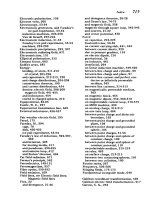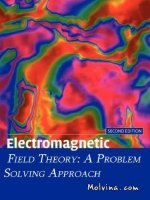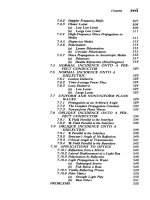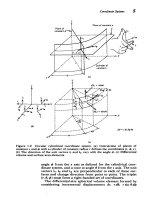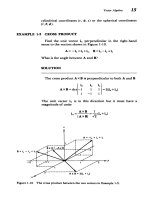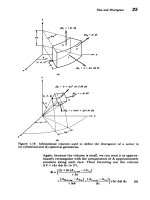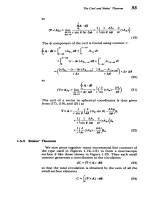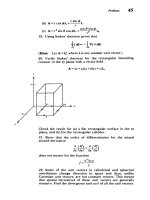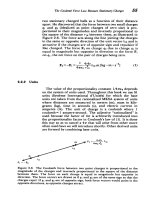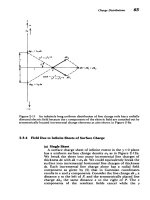Electromagnetic Field Theory: A Problem Solving Approach Part 11 potx
Bạn đang xem bản rút gọn của tài liệu. Xem và tải ngay bản đầy đủ của tài liệu tại đây (335.23 KB, 10 trang )
Gauss's
Law
75
where
we
used
(4).
We
can
now
use
the
divergence
theorem
to
convert
the
surface
integral
to
a
volume
integral:
-q
fsE.dS=
4•
V[.
( '
]dV
(8)
41eo
IV
rqP)
When
the point
charge
q
is
outside
the
surface
every
point
in
the
volume
has
a
nonzero
value
of
rQp.
Then,
using
(6)
with
rQp
#
0,
we
see
that
the
net
flux
of
E
through
the
surface
is
zero.
This
result
can
be
understood
by
examining
Figure
2-15a.
The
electric
field
emanating
from
q
on
that
part
of
the
sur-
face S
nearest
q
has
its
normal
component
oppositely
directed
to
dS
giving a
negative
contribution
to
the
flux.
However,
on
the
opposite
side
of
S
the
electric
field
exits
with
its
normal
component
in
the
same
direction
as
dS
giving
a
positive
contribution
to
the
flux.
We
have shown
that
these
flux
contributions are
equal
in
magnitude but
opposite
in sign
so
that
the
net
flux
is
zero.
As
illustrated
in
Figure
2-15b,
assuming
q
to
be positive,
we
see
that
when
S
surrounds
the charge the
electric
field
points
outwards
with
normal
component
in
the
direction
of
dS
everywhere on
S
so
that
the flux
must
be
positive.
If
q
were
negative,
E
and
dS
would
be oppositely
directed
everywhere
so
that
the
flux
is
also
negative.
For
either
polarity
with
nonzero
q,
the
flux
cannot
be
zero.
To
evaluate
the
value
of
this
flux
we
realize
that
(8)
is
zero
everywhere
except
where
rQp
=
0
so
that
the
surface
S
in
(8)
can
be
shrunk
down
to
a
small
spherical surface
S'
of
infinitesimal
radius
Ar
sur-
rounding
the
point
charge; the rest
of
the
volume has
rQp
0
0
so
that
V
.V(l/rQp)
=
0.
On
this
incremental
surface
we
know
the
electric
field
is
purely
radial
in
the
same
direction
as
dS'
with
the
field
due
to
a
point
charge:
fE
EdS=f
E*
dS'
q=
q
(q(
s-
41reo(Ar)
(r)
(9)
If
we
had
many
point
charges
within
the surface
S,
each
charge
q, gives
rise
to
a
flux
qdso
so
that
Gauss's
law
states
that
the
net
flux of
e0E
through
a
closed
surface
is
equal
to
the
net
charge
enclosed
by
the
surface:
eoE
dS=
qi.
(10)
S
all
qi
inside
S
Any
charges
outside
S
do
not
contribute
to
the
flux.
(b)
Charge
Distributions
For
continuous
charge
distributions,
the
right-hand
side
of
(10)
includes
the
sum
of
all
enclosed
incremental
charge
76
The
Electric
Field
elements
so
that
the
total
charge
enclosed
may
be
a
line,
surface,
and/or
volume
integral
in
addition
to
the
sum
of
point
charges:
fseoE'dS=
_
qi
+
dq
S
all
qi
all
q
inside
S
inside
S
=(Qqi+f
Adl+
°dS+
~pdV)
(11)
all
charge
inside
S
Charges
outside the
volume
give
no
contribution
to
the
total
flux
through
the
enclosing
surface.
Gauss's
law
of
(11)
can
be
used
to
great
advantage
in
simplifying
computations
for
those
charges
distributed
with
spatial
symmetry.
The
trick
is
to
find
a
surface
S
that
has
sections
tangent
to
the
electric
field
so
that
the
dot
product
is
zero,
or
has
surfaces
perpendicular
to
the
electric
field
and
upon
which
the
field
is
constant
so
that
the
dot
product
and
integration
become
pure
multiplications.
If
the
appropriate
surface
is
found,
the
surface
integral
becomes
very
simple
to
evaluate.
Coulomb's
superposition
integral
derived
in
Section
2.3.2
is
often
used
with
symmetric
charge
distributions
to
determine
if
any
field
components
are
zero.
Knowing
the
direction
of
the
electric
field
often
suggests
the
appropriate
Gaussian
sur-
face
upon
which
to
integrate
(11).
This
integration
is
usually
much
simpler
than
using
Coulomb's
law
for
each
charge
element.
2-4-3
Spherical
Symmetry
(a)
Surface Charge
A
sphere
of
radius
R
has
a
uniform
distribution
of
surface
charge
o'o
as
in
Figure
2-16a.
Measure
the
angle
0
from
the
line
joining
any
point
P
at
radial
distance
r
to
the
sphere
center.
Then,
the distance
from
P
to
any
surface
charge
element
on
the
sphere
is
independent
of
the
angle
4.
Each
differential
surface
charge element
at
angle
0
contributes
field
components
in
the radial
and
0
directions,
but
sym-
metrically
located
charge
elements
at
-0
have
equal
field
magnitude
components
that
add
radially
but
cancel
in
the
0
direction.
Realizing
from
the
symmetry
that
the
electric
field
is
purely
radial
and
only
depends
on
r
and not
on
0
or
4,
we
draw
Gaussian
spheres
of
radius
r
as
in
Figure
2-16b
both
inside
(r <
R)
and
outside
(r >
R)
the
charged sphere.
The
Gaussian
sphere
inside
encloses
no
charge
while
the outside
sphere
_··
Gauss's
Law
77
dE
enclosed
s
r
Figure
2-16
A
sphere
of
radius
R
with
uniformly
distributed
surface
charge
oo.
(a)
Symmetrically
located
charge
elements
show
that
the
electric
field
is
purely radial.
(b)
Gauss's
law,
applied
to
concentric
spherical
surfaces
inside
(r
<
R)
and
outside
(r
>
R)
the
charged sphere,
easily
shows
that
the
electric
field
within
the
sphere
is
zero
and
outside
is
the
same
as
if
all
the
charge
Q
=
47rR-2o
were
concentrated
as
a
point
charge
at
the
origin.
encloses
all
the charge
Q
=
o0o47rR2
o047rR2=
Q,
r>R
cs
E
•
dS
=
EoE,4iwr
2
=2)
0,
r<R
so
that
the
electric
field
is
'
0
R
2
Q
2
-
,
r>R
Er=
e
0
r
4reor
(13)
0,
r<R
The
integration
in
(12)
amounts
to
just
a
multiplication
of
eoEr
and
the
surface
area
of
the
Gaussian
sphere
because
on
the
sphere
the
electric
field
is
constant
and
in
the
same
direc-
tion
as
the
normal
i,.
The
electric
field
outside
the
sphere
is
the
same
as
if
all
the
surface
charge
were
concentrated
as
a
point charge
at
the origin.
The
zero
field
solution
for
r
<R
is
what
really
proved
Coulomb's
law.
After
all,
Coulomb's
small
spheres
were
not
really
point
charges
and
his
measurements
did
have
small
sources
of
errors.
Perhaps
the
electric
force
only
varied
inversely
with
distance
by
some
power
close
to
two,
r-2+,
where
8
is
very
small.
However,
only
the
inverse
square
law
dE
otal
rface
arge
Q=
4rR
2
o
0
losed
Iosed
Gaussian
arge
!
78 The
Electric
Field
gives
a
zero
electric
field
within
a
uniformly
surface
charged
sphere.
This
zero
field result-is
true
for
any
closed
conducting
body
of
.arbitrary
shape
charged
on
its
surface
with
no
enclosed
charge.
Extremely
precise
measurements
were
made
inside
such
conducting
surface
charged
bodies
and
the
electric
field
was
always
found
to
be
zero.
Such
a
closed
conducting
body
is
used
for
shielding
so
that
a
zero
field
environment
can
be
isolated
and
is
often
called
a
Faraday
cage,
after
Faraday's
measurements
of
actually
climbing
into
a
closed
hollow
conducting
body
charged
on
its
surface
to
verify
the
zero
field
results.
To
appreciate
the
ease
of
solution
using
Gauss's
law,
let
us
redo
the
problem
using the
superposition
integral
of
Section
2.3.2.
From
Figure
2-16a
the
incremental
radial
component
of
electric
field
due
to
a
differential
charge element
is
-ooR
2
sin
0
dO
do
dE,
= 92rr
cos
a
(14)
From
the
law
of
cosines
the
angles
and
distances
are
related
as
rp
=
+ R -
2rR
cos
0
2
2
2(15)
R =
r
2
+rQP
-
2rrQpcosa
so
that
a
is
related
to
0
as
r-R
cos
0
cos
a
=2
2
[r
+R
-2rR
cos
0]
2
(16)
Then
the
superposition integral
of
Section
2.3.2
requires
us
to
integrate
(14)
as
r
"w
o
0
R
2
sin
8(r-R
cos
8)
d0
d4
E6=
Jo=
0
4ireo[r
+R
-2rR
cos
0]132
After
performing
the
easy
integration
over
4
that
yields
the
factor of
21r,
we
introduce
the change
of variable:
u=
r2+R
-2rR
cos
0
du
=
2rR
sin
0d
(18)
which
allows
us
to
rewrite
the
electric
field
integral
as
'(+E)r
roR[u+r
-R
]
du
E,=
i
=
(,_R-)
8eor/
-oR
i
1/2
(r
2
-R
2
)
(r+R)2
oR
1I2
I
(r-R)
=-oR
(r+R)-r-RI
-(r
-R
2
)(rR
-
(19)
Gauss's
Law
79
where
we
must
be
very
careful
to
take
the
positive
square
root
in
evaluating
the
lower
limit
of
the integral
for
r
<
R.
Evalu-
ating
(19)
for
r
greater
and
less
than
R
gives
us
(13),
but
with
a lot
more
effort.
(b)
Volume
Charge
Distribution
If
the
sphere
is
uniformly
charged
throughout
with
density
po,
then
the
Gaussian
surface
in
Figure
2-17a
for
r>R
still
encloses
the
total
charge
Q
=lrR
p
o.
However,
now
the
smaller
Gaussian
surface
with
r
<R
encloses
a
fraction
of
the
total
charge:
Po1rr
=
Q(r/R)-,
s
eoE
•
dS
=
eoE,4rr
2
SooR
R
3
=
Q,
Er
=
(r
>
R)
4wenr
2
Total
volume
charge
/
Q
=
Po14)rR3
1
Enclosed
R
Figure
2-17
(a)
Gat
electric
field
outside
t:
concentrated
as
a
poil
the contributions
fror
r<R
r>R
\
80
The Electric
Field
so
that
the
electric
field
is
rpor
_Qr
E
SeO
47reoR
3
r<R
E,
= o
(21)
poR
3
Q
S=
2
,
r>R
3eo
0
r-
4reor
2
>
R
This result
could
also
have
been
obtained
using
the
results
of
(13)
by
breaking
the
spherical
volume
into
incremental
shells
of
radius
r',
thickness
dr',
carrying
differential
surface
charge
do,
=
Po
dr'
as
in
Figure
2-17b.
Then
the
contribution
to
the
field
is
zero
inside
each shell
but
nonzero
outside:
0,
r
< r'
dE,
=
por
'
2
dr'
(22)
eor
The
total
field
outside
the
sphere
is
due
to
all
the
differential
shells,
while
the
field
inside
is
due
only
to
the
enclosed
shells:
r
r12po
dr'
por
Qrr
S2
-
3,
r<R
{
eor
3eo
4ireoR
3
E,=
1
z
(23)
E
r'20
dr'
poR
S
Q
-
2'
=
r>R
o
Er
2
3eor
4r
l
eor
which
agrees
with
(21).
2-4-4
Cylindrical
Symmetry
(a)
Hollow
Cylinder
of
Surface
Charge
An
infinitely
long
cylinder
of
radius
a
has
a
uniform
dis-
tribution
of
surface
charge
oo,
as
shown
in
Figure
2-18a.
The
angle
0
is
measured from
the
line
joining
the
field
point
P
to
the
center
of
the
cylinder.
Each
incremental
line
charge
ele-
ment
dA
=
coa
do
contributes
to
the
electric
field
at
P
as
given
by
the
solution
for an
infinitely
long
line
charge
in
Section
2.3.3.
However,
the
symmetrically
located
element
at
-4
gives
rise
to
equal
magnitude
field
components
that
add
radially
as
measured
from
the
cylinder
center
but
cancel
in
the
4
direction.
Because
of
the
symmetry,
the
electric
field
is
purely
radial
so
that
we
use
Gauss's
law
with
a
concentric
cylinder
of
radius
r and
height
L,
as
in
Figure
2-18b
where
L
is
arbitrary.
There
is
no
contribution
to
Gauss's
law
from
the
upper
and
lower
surfaces
because
the
electric
field
is
purely
tangential.
Along
the
cylindrical
wall
at
radius
r,
the
electric
field
is
constant
and
Gauss's
Law
81
,dET
=
dEl
+
dE
2
a)
E
r
=
oa
r
>a
e
o
r
d
=
ooado
' O
0
Po
dr'
(b)
S
p
o
r'dr'
dE,
=
r>r'
0
r
<
r'
Figure
2-18
(a)
Symmetrically
located
line
charge
elements
on
a
cylinder
with
uni-
formly
distributed
surface
charge
show
that
the
electric
field
is
purely
radial.
(b)
Gauss's
law
applied
to
concentric
cylindrical
-surfaces
shows
that
the
field
inside
the
surface
charged
cylinder
is
zero
while
outside
it
is
the
same
as
if
all
the
charge
per
unit
length
o0
27ra
were
concentrated
at
the
origin
as
a
line
charge.
(c)
In addition
to
using
the
surfaces
of
(b)
with Gauss's
law
for
a
cylinder
of volume
charge,
we
can
also
sum
the
contributions
from incremental
hollow
cylinders of
surface
charge.
purely
normal
so
that
Gauss's
law
simply
yields
EoE
dS
=
eor27rrL
=
(24)
0
r<a
where
for
r
<a
no
charge
is
enclosed,
while
for
r>
a
all
the
charge
within
a
height
L
is
enclosed.
The
electric
field
outside
the
cylinder
is
then
the
same
as
if
all
the charge
per
unit
dh
2
=
ooad
+
82
The
Electric
Field
length
A
=
o-o2rra
were
concentrated
along
the
axis
of
the
cylinder:
o-oa
A
-
r>a
E,=
Eor
2TEor
(25)
(25)
0,
r<a
Note
in
(24)
that
the
arbitrary
height
L
canceled
out.
(b)
Cylinder
of
Volume
Charge
If
the
cylinder
is
uniformly
charged
with
density
po,
both
Gaussian
surfaces
in
Figure
2-18b
enclose
charge
o
E
dS
=
oE,
2rL
=
L
(26)
s
poirr
2
L,
r<a
(26)
so
that
the
electric
field
is
poa
A
, r>a
E
2eor
21reor
(27)
Er
=por
_
Ar
2
r<a
2e
0
27reoa
where
A
=poira
2
is
the
total
charge
per
unit
length
on the
cylinder.
Of
course,
this
result
could
also
have
been
obtained
by
integrating
(25)
for
all
differential
cylindrical
shells
of
radius
r'
with
thickness
dr'
carrying
incremental
surface
charge
dor
=
Po
dr',
as
in
Figure
2-18c.
a
por
dr=poa
A
dr'=
,
r>a
ear
2eor
27reor
Er=
(28)
p
or
'
po
r
=
Ar
for
2eo
2rTeoa
2-4-5
Gauss's
Law
and
the
Divergence
Theorem
If
a
volume
distribution
of
charge
p
is
completely
sur-
rounded
by
a
closed
Gaussian
surface
S,
Gauss's
law
of
(11)
is
~seoE
dS=
pdV
(29)
The
left-hand
side
of
(29)
can
be
changed
to
a
volume
integral
using
the
divergence
theorem:
seoE.dS=
V
(oE)dV=
pdV
(30)
I_
__
·_
Gauss's
Law
83
Since
(30)
must
hold
for
any
volume,
the
volume
integrands
in
(30)
must
be
equal,
yielding
the
point
form
of
Gauss's
law:
V
(eoE)=p
(31)
Since
the
permittivity
of
free
space
eo
is
a
constant,
it can
freely
move
outside
the
divergence
operator.
2-4-6
Electric
Field
Discontinuity
Across
a
Sheet
of
Surface Charge
In
Section
2.3.4a
we
found
that
the
electric
field
changes
direction
discontinuously
on
either
side
of
a
straight
sheet
of
surface
charge.
We
can
be
more general
by
applying
the
surface integral
form
of
Gauss's
law
in
(30)
to
the
differential-
sized
pill-box
surface
shown
in
Figure
2-19
surrounding
a
small
area
dS
of
surface
charge:
fseoE.dS=
sodS
o(E
2
,-E,.)
dS=
rdS
(32)
where
E2.
and
El.
are
the
perpendicular
components
of
electric
field
on
each
side
of
the interface.
Only
the
upper
and
lower
surfaces of
the
pill-box
contribute
in
(32)
because
the
surface
charge
is
assumed
to
have zero
thickness
so
that
the
short
cylindrical
surface
has
zero
area.
We
thus
see
that
the
surface
charge
density
is
proportional
to
the discontinuity
in
the
normal
component
of electric
field
across
the
sheet:
E
0
(E
2
.
-El.)
=
o-
n
-
EO(E
2
-
EL)
=
o-
(33)
where
n
is
perpendicular
to
the interface
directed
from
region
1
to
region
2.
dS
=
ndS
Figure
2-19
Gauss's
law
applied
to
a
differential
sized
pill-box
surface
enclosing
some
surface
charge
shows
that
the normal
component
of
e
0
E
is
discontinuous
in
the
surface
charge
density.
84
The
Electric
Field
2-5
THE
ELECTRIC
POTENTIAL
If
we
have
two
charges
of
opposite
sign,
work
must
be
done
to
separate
them
in
opposition
to
the
attractive
coulomb
force.
This
work
can be
regained
if
the
charges
are
allowed to
come
together.
Similarly,
if
the
charges
have
the
same
sign,
work
must
be
done
to
push
them
together;
this work
can
be
regained
if
the
charges
are
allowed
to
separate.
A
charge
gains
energy
when
moved
in
a
direction opposite
to
a
force.
This
is
called
potential energy
because
the
amount
of
energy
depends
on
the
position of
the
charge
in
a
force
field.
2-5-1
Work
Required
to
Move
a
Point
Charge
The
work
W
required
to
move
a
test
charge
q,
along
any
path from
the
radial
distance
r,
to
the
distance
rb
with
a
force
that
just
overcomes
the
coulombic
force
from
a
point
charge
q,
as
shown in
Figure
2-20,
is
W=
-
F-
dl
qq,
'bi,
-
dl
F7e
v.
r
Figure
2-20
It
takes
no
work
to
move
a
test
charge
q,
along
the
spherical surfaces
perpendicular
to
the
electric
field
due
to
a
point
charge
q.
Such
surfaces
are
called
equipotential
surfaces.
